Do you send a lot of sensitive email with Outlook with an Office 365 subscription? If so, you’re in luck.
Introduced with Office 365, Microsoft provides you with a built-in service to encrypt Outlook email. The service called Message Encryption is built into Office 365. Along with encryption, the service can also ensure your messages can’t be forwarded and even ensure your email gets to the intended recipient.
In this tutorial, you’re going to learn how to encrypt Outlook email to/from your Office 365 account to keep those emails secure! You’ll learn how to encrypt email with Outlook on your desktop and Outlook on the Web.
Prerequisites
This article will be a tutorial. If you’d like to follow along, please ensure you have these prerequisites:
- A Microsoft 365 subscription (Personal, Family or via a corporate subscription)
- Outlook – Download and install Office apps from the official page
Encrypt Outlook on Desktop
Let’s get started with Outlook on the desktop! Assuming you have Outlook installed on your PC, follow these steps to encrypt an email:
1. Launch the Outlook Application and login to your Outlook or Microsoft account.
2. Compose a new email by clicking on New Email, as shown below. Doing so will open a separate message composer window.

3. In the separate message composer window, click on the Options tab as shown below in the following screenshot.
Right below the padlock icon on the toolbar, click on Encrypt, followed by the permission you’d like to apply to this email.
Outlook groups various “permissions” under the umbrella of “encryption,” which may be confusing. If you set any “permission'” in the Encrypt dropdown, the email will be encrypted. If you choose a “permission” other than Encrypt-Only other features will be added to the email.
Outlook provides you with four options for email protection.
- Encrypt Only – This only encrypts the message without additional permissions.
- Do Not Forward – Recipients can read the message but cannot forward, print, or copy the content. The data owner has full permission to their message and all replies.
- Confidential \ All Employees – Requires protection which allows all employees full permissions. Data owners can track and revoke content.
- Highly Confidential \ All Employees – Allows all employees to view, edit, and reply permissions to this content. Data owners can track and revoke content.
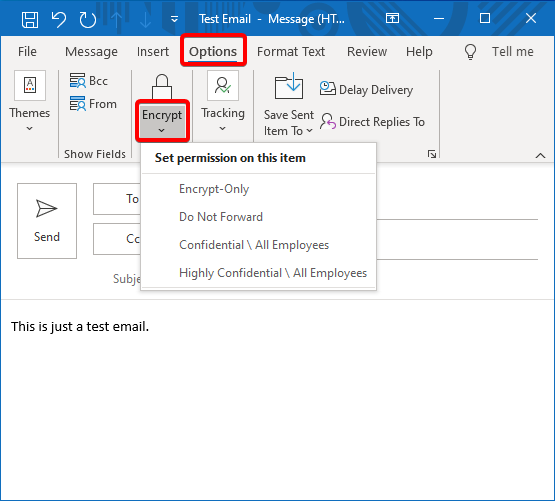
4. Now, send your email knowing that it’s fully protected.
Encrypting Email with Outlook on the Web (Outlook.com)
Encrypting email in outlook.com is just about the same as using the desktop version. Follow these steps to encrypt an email if you prefer to use Outlook on the Web:
1. Launch your favorite web browser and navigate to Outlook.com, logging in with your Microsoft account.
2. Compose an email by clicking on the New message button at the top-left corner of the page.
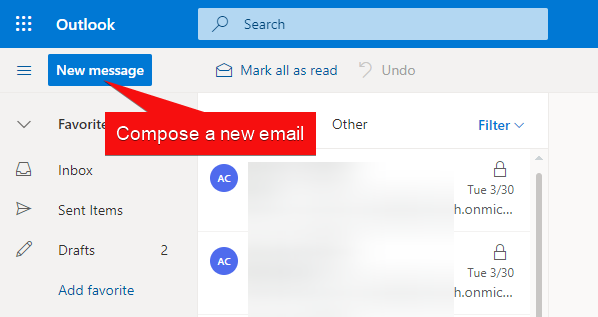
3. At the top of the message editor, click on the Encrypt link. This action will bring up the message editor.
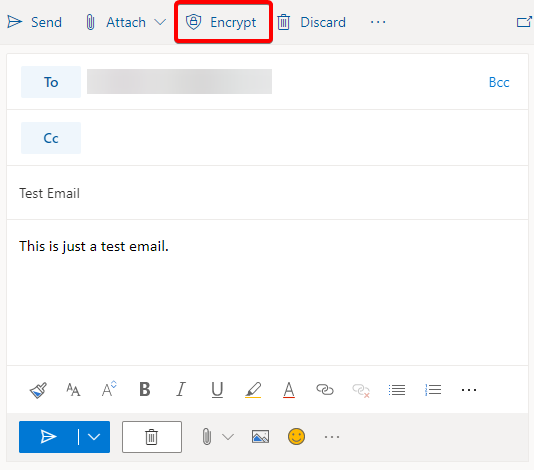
4. In the message editor, you’ll see a message pop-up at the top. To modify permissions for the email, click on the Change permissions link.
By default, all email sent with via outlook.com is encrypted.

5. From the pop-up window, click on the drop-down box and choose the permission to set for your email, then click OK.
The permissions to choose from are the same as demonstrated previously with Outlook on the desktop.
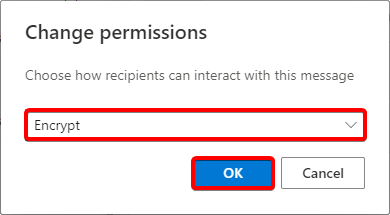
5. Now, send the encrypted email!
Reading Encrypted Email in Outlook
You’ve now learned how to send an encrypted email with Outlook, but that’s only half the story. Once sent, you also need to know how to read those emails if someone else sends an encrypted email to you.
Reading Encrypted Emails Sent from Office 365
If you are using Outlook and Office 365 and are sent an encrypted email from someone else on Office 365 and Outlook, you’ll see a padlock next to the message as shown below. This padlock on the email indicates it is encrypted and sent from another Office 365 account.

To decrypt it, open the email. There are no other hoops to jump through. But what if it came from another email provider?
Reading Encrypted Emails Sent from Other Email Providers
Different email providers have different ways to encrypt email. If you’re sent an email to your Office 365 account using Outlook, your experience won’t be as seamless as Office 365 —> Office 365.
Perhaps you’ve received an encrypted email from a Gmail account. Emails received from providers other than Office 365 usually have instructions on how to view the email content. But in this case, you’re able to read what’s inside the email by clicking on it.
To verify the email’s encryption details, click on the padlock icon at the email’s right-most part.
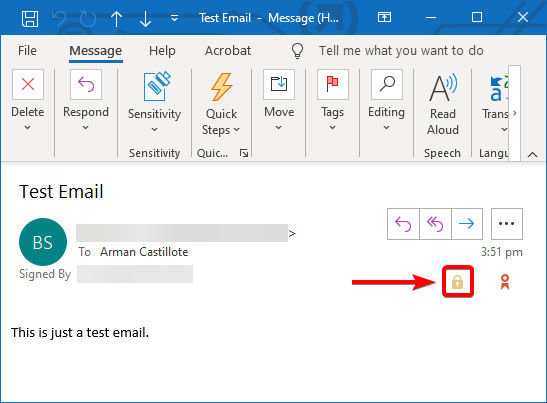
As you see in the screenshot, the Message Security Properties window shows that the email was encrypted and signed.

Manually Decrypting Email with ProtonMail
As mentioned in the previous example, receiving encrypted non-Outlook emails usually contains instructions to decrypt an email. Those instructions are dependent on which email provider the sender used to send the encrypted email.
ProtonMail is a popular, secure email client that can send encrypted emails to your Outlook inbox. Perhaps you were sent an encrypted email with ProtonMail, and you’d like to read it.
These instructions apply whether you’re using Outlook on desktop or Outlook on the web.
1. Launch the Outlook app or open a web browser, then navigate to Outlook.com and log in to your Outlook or Microsoft account.
2. Now, find and click on the ProtonMail encrypted email. Inside the email, click on the View Secure Message button. By doing so, your web browser will open a new tab, and you’ll get to a ProtonMail message decrypting page.
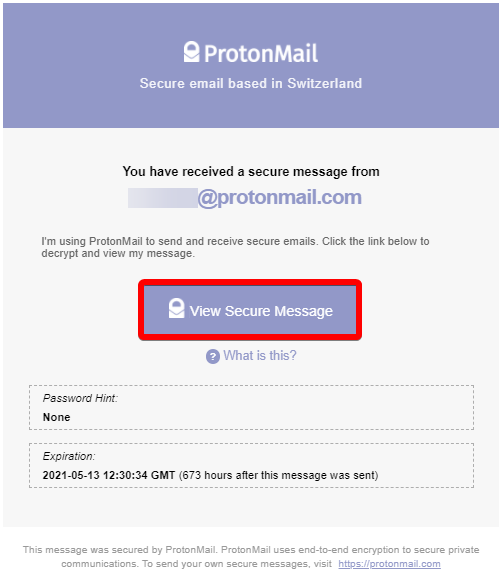
3. In your web browser, you’ll see a form in a ProtonMail environment. Type in the password that the sender has set up for the encrypted email and click the DECRYPT button.
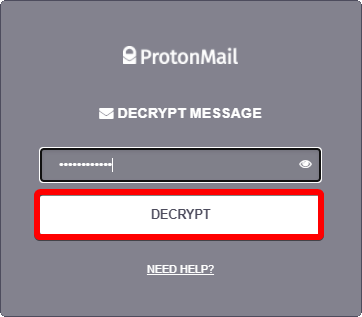
4. If decryption is successful, you’ll stay in a ProtonMail environment that lets you read the encrypted email content in your web browser.
Your access to the email content is only temporary. You’ll go through the same process the next time you open the email.
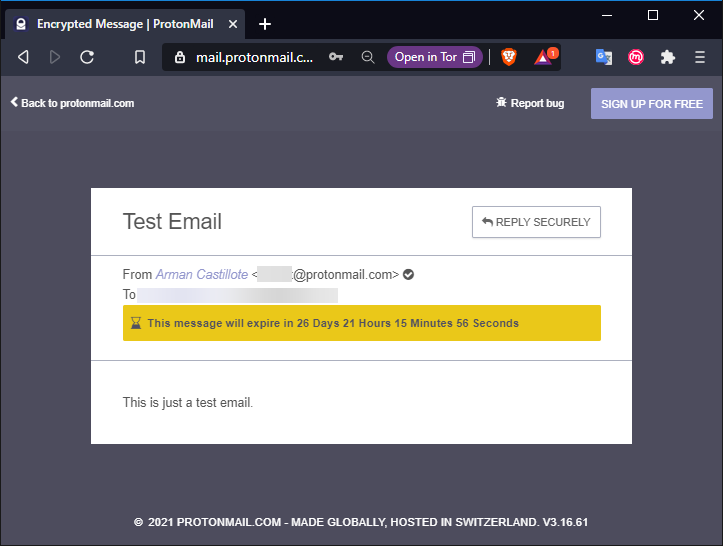
Conclusion
In this article, you’ve learned to send secure emails with Outlook and Office 365 and work decrypt emails from other email providers. You should now have the know-how to send and receive emails to keep your sensitive emails secure.
What email providers do you prefer for email encryption?



